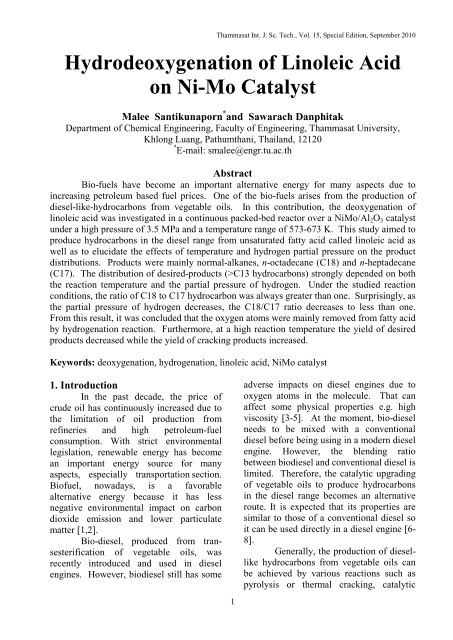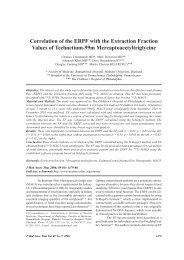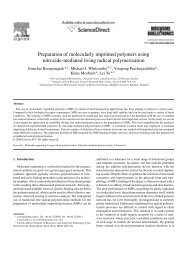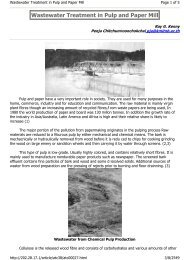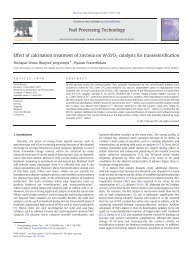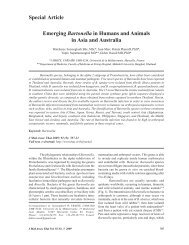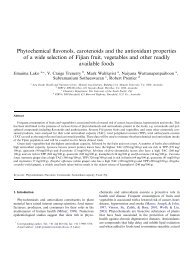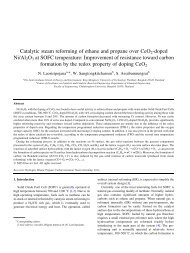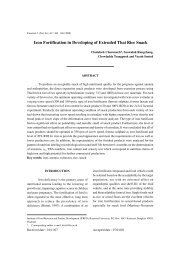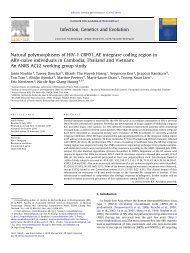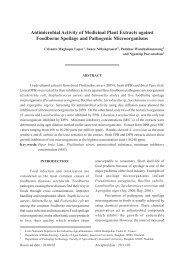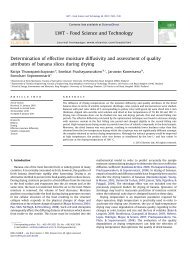Hydrodeoxygenation of Linoleic Acid on Ni-Mo Catalyst - ThaiScience
Hydrodeoxygenation of Linoleic Acid on Ni-Mo Catalyst - ThaiScience
Hydrodeoxygenation of Linoleic Acid on Ni-Mo Catalyst - ThaiScience
You also want an ePaper? Increase the reach of your titles
YUMPU automatically turns print PDFs into web optimized ePapers that Google loves.
Thammasat Int. J. Sc. Tech., Vol. 15, Special Editi<strong>on</strong>, September 2010<br />
<str<strong>on</strong>g>Hydrodeoxygenati<strong>on</strong></str<strong>on</strong>g> <str<strong>on</strong>g>of</str<strong>on</strong>g> <str<strong>on</strong>g>Linoleic</str<strong>on</strong>g> <str<strong>on</strong>g>Acid</str<strong>on</strong>g><br />
<strong>on</strong> <strong>Ni</strong>-<strong>Mo</strong> <strong>Catalyst</strong><br />
Malee Santikunaporn * and Sawarach Danphitak<br />
Department <str<strong>on</strong>g>of</str<strong>on</strong>g> Chemical Engineering, Faculty <str<strong>on</strong>g>of</str<strong>on</strong>g> Engineering, Thammasat University,<br />
Khl<strong>on</strong>g Luang, Pathumthani, Thailand, 12120<br />
* E-mail: smalee@engr.tu.ac.th<br />
Abstract<br />
Bio-fuels have become an important alternative energy for many aspects due to<br />
increasing petroleum based fuel prices. One <str<strong>on</strong>g>of</str<strong>on</strong>g> the bio-fuels arises from the producti<strong>on</strong> <str<strong>on</strong>g>of</str<strong>on</strong>g><br />
diesel-like-hydrocarb<strong>on</strong>s from vegetable oils. In this c<strong>on</strong>tributi<strong>on</strong>, the deoxygenati<strong>on</strong> <str<strong>on</strong>g>of</str<strong>on</strong>g><br />
linoleic acid was investigated in a c<strong>on</strong>tinuous packed-bed reactor over a <strong>Ni</strong><strong>Mo</strong>/Al2O3 catalyst<br />
under a high pressure <str<strong>on</strong>g>of</str<strong>on</strong>g> 3.5 MPa and a temperature range <str<strong>on</strong>g>of</str<strong>on</strong>g> 573-673 K. This study aimed to<br />
produce hydrocarb<strong>on</strong>s in the diesel range from unsaturated fatty acid called linoleic acid as<br />
well as to elucidate the effects <str<strong>on</strong>g>of</str<strong>on</strong>g> temperature and hydrogen partial pressure <strong>on</strong> the product<br />
distributi<strong>on</strong>s. Products were mainly normal-alkanes, n-octadecane (C18) and n-heptadecane<br />
(C17). The distributi<strong>on</strong> <str<strong>on</strong>g>of</str<strong>on</strong>g> desired-products (>C13 hydrocarb<strong>on</strong>s) str<strong>on</strong>gly depended <strong>on</strong> both<br />
the reacti<strong>on</strong> temperature and the partial pressure <str<strong>on</strong>g>of</str<strong>on</strong>g> hydrogen. Under the studied reacti<strong>on</strong><br />
c<strong>on</strong>diti<strong>on</strong>s, the ratio <str<strong>on</strong>g>of</str<strong>on</strong>g> C18 to C17 hydrocarb<strong>on</strong> was always greater than <strong>on</strong>e. Surprisingly, as<br />
the partial pressure <str<strong>on</strong>g>of</str<strong>on</strong>g> hydrogen decreases, the C18/C17 ratio decreases to less than <strong>on</strong>e.<br />
From this result, it was c<strong>on</strong>cluded that the oxygen atoms were mainly removed from fatty acid<br />
by hydrogenati<strong>on</strong> reacti<strong>on</strong>. Furthermore, at a high reacti<strong>on</strong> temperature the yield <str<strong>on</strong>g>of</str<strong>on</strong>g> desired<br />
products decreased while the yield <str<strong>on</strong>g>of</str<strong>on</strong>g> cracking products increased.<br />
Keywords: deoxygenati<strong>on</strong>, hydrogenati<strong>on</strong>, linoleic acid, <strong>Ni</strong><strong>Mo</strong> catalyst<br />
1. Introducti<strong>on</strong><br />
In the past decade, the price <str<strong>on</strong>g>of</str<strong>on</strong>g><br />
crude oil has c<strong>on</strong>tinuously increased due to<br />
the limitati<strong>on</strong> <str<strong>on</strong>g>of</str<strong>on</strong>g> oil producti<strong>on</strong> from<br />
refineries and high petroleum-fuel<br />
c<strong>on</strong>sumpti<strong>on</strong>. With strict envir<strong>on</strong>mental<br />
legislati<strong>on</strong>, renewable energy has become<br />
an important energy source for many<br />
aspects, especially transportati<strong>on</strong> secti<strong>on</strong>.<br />
Bi<str<strong>on</strong>g>of</str<strong>on</strong>g>uel, nowadays, is a favorable<br />
alternative energy because it has less<br />
negative envir<strong>on</strong>mental impact <strong>on</strong> carb<strong>on</strong><br />
dioxide emissi<strong>on</strong> and lower particulate<br />
matter [1,2].<br />
Bio-diesel, produced from transesterificati<strong>on</strong><br />
<str<strong>on</strong>g>of</str<strong>on</strong>g> vegetable oils, was<br />
recently introduced and used in diesel<br />
engines. However, biodiesel still has some<br />
1<br />
adverse impacts <strong>on</strong> diesel engines due to<br />
oxygen atoms in the molecule. That can<br />
affect some physical properties e.g. high<br />
viscosity [3-5]. At the moment, bio-diesel<br />
needs to be mixed with a c<strong>on</strong>venti<strong>on</strong>al<br />
diesel before being using in a modern diesel<br />
engine. However, the blending ratio<br />
between biodiesel and c<strong>on</strong>venti<strong>on</strong>al diesel is<br />
limited. Therefore, the catalytic upgrading<br />
<str<strong>on</strong>g>of</str<strong>on</strong>g> vegetable oils to produce hydrocarb<strong>on</strong>s<br />
in the diesel range becomes an alternative<br />
route. It is expected that its properties are<br />
similar to those <str<strong>on</strong>g>of</str<strong>on</strong>g> a c<strong>on</strong>venti<strong>on</strong>al diesel so<br />
it can be used directly in a diesel engine [6-<br />
8].<br />
Generally, the producti<strong>on</strong> <str<strong>on</strong>g>of</str<strong>on</strong>g> diesellike<br />
hydrocarb<strong>on</strong>s from vegetable oils can<br />
be achieved by various reacti<strong>on</strong>s such as<br />
pyrolysis or thermal cracking, catalytic
cracking and deoxygenati<strong>on</strong>. Both thermal<br />
and catalytic cracking yield high volume <str<strong>on</strong>g>of</str<strong>on</strong>g><br />
hydrocarb<strong>on</strong>s, but they cannot provide high<br />
yield <str<strong>on</strong>g>of</str<strong>on</strong>g> diesel range while deoxygenati<strong>on</strong><br />
can preserve hydrocarb<strong>on</strong>s in the diesel<br />
range [9]. Dupain et al. [10] investigated<br />
the catalytic cracking <str<strong>on</strong>g>of</str<strong>on</strong>g> rapeseed vegetable<br />
oil under realistic FCC c<strong>on</strong>diti<strong>on</strong>s.<br />
Hydrocarb<strong>on</strong> products were in both<br />
gasoline- and diesel-range. In additi<strong>on</strong>,<br />
they obtained a large amount <str<strong>on</strong>g>of</str<strong>on</strong>g> aromatics<br />
in the gasoline fracti<strong>on</strong>.<br />
Triglyceride or fatty acids can be<br />
deoxygenated through decarb<strong>on</strong>ylati<strong>on</strong>,<br />
decarboxylati<strong>on</strong> and hydrogenati<strong>on</strong> [11].<br />
Maki-Arvela et al. [12] and Kubičková et al.<br />
[13] studied the deoxygenati<strong>on</strong> <str<strong>on</strong>g>of</str<strong>on</strong>g> stearic<br />
acid, ethyl stearate, and tristearine over a<br />
Pd/C catalyst in a semi-batch reactor under<br />
helium and low hydrogen partial pressure.<br />
They found that the main product obtained<br />
from those reactants was n-heptadecane,<br />
which mainly occurred via decarboxylati<strong>on</strong><br />
<str<strong>on</strong>g>of</str<strong>on</strong>g> stearic acid and via decarb<strong>on</strong>ylati<strong>on</strong> <str<strong>on</strong>g>of</str<strong>on</strong>g> its<br />
derivatives.<br />
In this paper, deoxygenati<strong>on</strong> <str<strong>on</strong>g>of</str<strong>on</strong>g><br />
unsaturated fatty acid was investigated <strong>on</strong> a<br />
commercial <strong>Ni</strong><strong>Mo</strong>/γ-Al2O3 catalyst in a<br />
flow reactor under a flow <str<strong>on</strong>g>of</str<strong>on</strong>g> hydrogen. The<br />
aims <str<strong>on</strong>g>of</str<strong>on</strong>g> this study are to evaluate the<br />
catalyst performance and products obtained<br />
from deoxygenati<strong>on</strong> reacti<strong>on</strong>.<br />
2. Experimental<br />
2.1 Chemicals<br />
<str<strong>on</strong>g>Linoleic</str<strong>on</strong>g> acid, mainly found in<br />
soybean and sunflower oils, was used as an<br />
unsaturated fatty acid feed. <str<strong>on</strong>g>Linoleic</str<strong>on</strong>g> acid<br />
(>99%) was purchased from Acros.<br />
Dodecane (>99% from Acros) was used as<br />
a solvent. A model compound for the<br />
hydrodeoxygenati<strong>on</strong> was a 5-10%wt. <str<strong>on</strong>g>of</str<strong>on</strong>g><br />
linoleic acid in dodecane, which was used<br />
as a feed. A commercial <strong>Ni</strong><strong>Mo</strong>/γ-Al2O3 in a<br />
reduced form was used as catalyst.<br />
Thammasat Int. J. Sc. Tech., Vol. 15, Special Editi<strong>on</strong>, September 2010<br />
2<br />
2.2 Catalytic Testing<br />
The apparatus used for deoxygenati<strong>on</strong> is<br />
illustrated schematically in Fig. 1.<br />
Fig. 1 A schematic experimental setup for<br />
deoxygenati<strong>on</strong>.<br />
The reacti<strong>on</strong> was performed in a<br />
c<strong>on</strong>tinuous fixed bed stainless steel ½” I.D.<br />
reactor equipped with an electric heating<br />
furnace and a thermocouple was placed in<br />
the center <str<strong>on</strong>g>of</str<strong>on</strong>g> the catalyst bed. A liquid<br />
c<strong>on</strong>denser was placed <strong>on</strong> the outlet <str<strong>on</strong>g>of</str<strong>on</strong>g> the<br />
reactor. The pressure inside the reactor was<br />
c<strong>on</strong>trolled by a back pressure regulator with<br />
a flow <str<strong>on</strong>g>of</str<strong>on</strong>g> N2. In each experiment, a specified<br />
amount <str<strong>on</strong>g>of</str<strong>on</strong>g> catalyst was placed in the<br />
center <str<strong>on</strong>g>of</str<strong>on</strong>g> the reactor. To ensure an effective<br />
preheating and minimize heat losses, the top<br />
and the bottom <str<strong>on</strong>g>of</str<strong>on</strong>g> the catalyst bed were<br />
filled with glass beads <str<strong>on</strong>g>of</str<strong>on</strong>g> 1 mm in a<br />
diameter. Before starting the feed, the<br />
catalyst was reduced in situ at 633 K for 4 h<br />
in a H2 flow. The catalytic activity was<br />
evaluated at a c<strong>on</strong>stant total pressure <str<strong>on</strong>g>of</str<strong>on</strong>g> 3.5<br />
MPa at a temperature range <str<strong>on</strong>g>of</str<strong>on</strong>g> 573-653 K<br />
under the H2 flow and at W/F ratio <str<strong>on</strong>g>of</str<strong>on</strong>g> 0.7 h.<br />
To elucidate the influence <str<strong>on</strong>g>of</str<strong>on</strong>g> hydrogen<br />
partial pressure <strong>on</strong> the deoxygenati<strong>on</strong>,<br />
different ratios <str<strong>on</strong>g>of</str<strong>on</strong>g> hydrogen to helium were<br />
applied. In all runs, reactant and product<br />
mixtures were analyzed using a HP6890<br />
and Fis<strong>on</strong>s 8000 series gas chromatographs<br />
equipped with a flame i<strong>on</strong>izati<strong>on</strong> detector.
3. Results and Discussi<strong>on</strong>s<br />
3.1 <strong>Catalyst</strong> Deactivati<strong>on</strong><br />
The deoxygenati<strong>on</strong> <str<strong>on</strong>g>of</str<strong>on</strong>g> linoleic acid<br />
was evaluated <strong>on</strong> a <strong>Ni</strong><strong>Mo</strong> catalyst at a<br />
c<strong>on</strong>stant pressure <str<strong>on</strong>g>of</str<strong>on</strong>g> 3.5 MPa and a<br />
temperature <str<strong>on</strong>g>of</str<strong>on</strong>g> 613 K under a H2 flow for<br />
13 h. This study aims to produce diesellike-hydrocarb<strong>on</strong><br />
so <strong>on</strong>ly desired products,<br />
which c<strong>on</strong>tain more than 12 carb<strong>on</strong> atoms in<br />
their molecule, were reported. The pr<str<strong>on</strong>g>of</str<strong>on</strong>g>ile<br />
<str<strong>on</strong>g>of</str<strong>on</strong>g> total amount <str<strong>on</strong>g>of</str<strong>on</strong>g> desired products was<br />
shown in Fig. 2.<br />
Fig. 2 Total amount <str<strong>on</strong>g>of</str<strong>on</strong>g> desired products<br />
obtained from the deoxygenati<strong>on</strong> <str<strong>on</strong>g>of</str<strong>on</strong>g> linoleic<br />
acid as a functi<strong>on</strong> <str<strong>on</strong>g>of</str<strong>on</strong>g> time <strong>on</strong> stream.<br />
As seen from fig. 2, the amount <str<strong>on</strong>g>of</str<strong>on</strong>g><br />
desired products decreases from 60.7% to<br />
43.6% after 13 h. This indicates the deactivati<strong>on</strong><br />
<str<strong>on</strong>g>of</str<strong>on</strong>g> the catalyst.<br />
Thammasat Int. J. Sc. Tech., Vol. 15, Special Editi<strong>on</strong>, September 2010<br />
3<br />
Fig. 3 (a) Desired products distributi<strong>on</strong> and<br />
(b) desired products selectivity obtained<br />
from the hydrodeoxygenati<strong>on</strong> <str<strong>on</strong>g>of</str<strong>on</strong>g> linoleic<br />
acid as a functi<strong>on</strong> <str<strong>on</strong>g>of</str<strong>on</strong>g> time <strong>on</strong> stream.<br />
For clarificati<strong>on</strong>, the desired products<br />
are classified into C18, C17 and C13-<br />
C16 products. The distributi<strong>on</strong> <str<strong>on</strong>g>of</str<strong>on</strong>g> desired<br />
products and their selectivities obtained<br />
from the deoxygenati<strong>on</strong> <str<strong>on</strong>g>of</str<strong>on</strong>g> linoleic acid are<br />
shown in Fig. 3(a) and (b). In this study,<br />
the terms <str<strong>on</strong>g>of</str<strong>on</strong>g> product yield and product<br />
selectivity are defined as the following<br />
equati<strong>on</strong>s:<br />
Yield A,%<br />
= % wt.<br />
<str<strong>on</strong>g>of</str<strong>on</strong>g> product A obtained<br />
% wt.<br />
<str<strong>on</strong>g>of</str<strong>on</strong>g> product A obtained<br />
Selectivity<br />
A,%<br />
=<br />
× 100%<br />
% wt.<br />
<str<strong>on</strong>g>of</str<strong>on</strong>g> total products obtained<br />
The main products are n-paraffins,<br />
which are n-octadecane (C18) and nheptadecane<br />
(C17). The n-octadecane<br />
corresp<strong>on</strong>ded to hydrogenati<strong>on</strong> <str<strong>on</strong>g>of</str<strong>on</strong>g> linoleic<br />
acid resulting from high H2/fatty acid ratio<br />
[10]. In c<strong>on</strong>trast, n-heptadecane corresp<strong>on</strong>ded<br />
to (hydro) decarb<strong>on</strong>ylati<strong>on</strong>/ decarboxylati<strong>on</strong><br />
<str<strong>on</strong>g>of</str<strong>on</strong>g> linoleic acid resulting from<br />
the formati<strong>on</strong> <str<strong>on</strong>g>of</str<strong>on</strong>g> carb<strong>on</strong> m<strong>on</strong>oxide/ carb<strong>on</strong><br />
dioxide. These main reacti<strong>on</strong>s are shown<br />
below:
2C 18H 32O 2 + 5H 2<br />
C 18H 32O 2 + 2H 2<br />
2C 17H 36+CO 2+CO+H 2O<br />
C 18H 38 + 2H 2O<br />
3.2 Effect <str<strong>on</strong>g>of</str<strong>on</strong>g> the reacti<strong>on</strong> temperature<br />
The linoleic acid reacti<strong>on</strong> was<br />
performed under different reacti<strong>on</strong> temperatures.<br />
The variati<strong>on</strong> <str<strong>on</strong>g>of</str<strong>on</strong>g> effluent is presented<br />
in Fig. 4. At low temperature the total<br />
amount <str<strong>on</strong>g>of</str<strong>on</strong>g> desired product increases as the<br />
reacti<strong>on</strong> temperature increases. Bey<strong>on</strong>d a<br />
certain temperature (623 K), the cracking<br />
reacti<strong>on</strong> is dominant and leads to decrease<br />
<str<strong>on</strong>g>of</str<strong>on</strong>g> desired products.<br />
Fig. 4 The total desired products yield as a<br />
functi<strong>on</strong> <str<strong>on</strong>g>of</str<strong>on</strong>g> the reacti<strong>on</strong> temperature.<br />
Figs. 5(a) and 5(b) represent the<br />
yields and selectivities <str<strong>on</strong>g>of</str<strong>on</strong>g> C18, C17 and<br />
other desired products, respectively. As<br />
discussed above, the main reacti<strong>on</strong>s for the<br />
deoxygenati<strong>on</strong> <str<strong>on</strong>g>of</str<strong>on</strong>g> fatty acid are hydrogenati<strong>on</strong><br />
and decarb<strong>on</strong>ylati<strong>on</strong>/decarboxylati<strong>on</strong>.<br />
From the results, under the studied<br />
reacti<strong>on</strong> c<strong>on</strong>diti<strong>on</strong>s, hydrogenati<strong>on</strong> is<br />
dominant. Therefore, the C18 hydrocarb<strong>on</strong><br />
is found with higher selectivity than the C17<br />
hydrocarb<strong>on</strong>. However, at high temperature,<br />
the selectivity <str<strong>on</strong>g>of</str<strong>on</strong>g> C18 is reduced resulting<br />
from thermodynamics. Whereas the hydrogenati<strong>on</strong><br />
reacti<strong>on</strong> is an exothermic reacti<strong>on</strong>,<br />
the decarb<strong>on</strong>ylati<strong>on</strong>/decarboxyla-ti<strong>on</strong> is an<br />
endothermic reacti<strong>on</strong>. So, the reacti<strong>on</strong><br />
temperature highly affects the product<br />
distributi<strong>on</strong>.<br />
Thammasat Int. J. Sc. Tech., Vol. 15, Special Editi<strong>on</strong>, September 2010<br />
4<br />
3.3 Effect <str<strong>on</strong>g>of</str<strong>on</strong>g> hydrogen partial pressure<br />
To elucidate the effect <str<strong>on</strong>g>of</str<strong>on</strong>g> hydrogen<br />
c<strong>on</strong>centrati<strong>on</strong>, the deoxygenati<strong>on</strong> <str<strong>on</strong>g>of</str<strong>on</strong>g> linoleic<br />
acid under different hydrogen partial<br />
pressures was performed.<br />
Fig. 5 (a) Desired products distributi<strong>on</strong> and<br />
(b) Desired products selectivity as a<br />
functi<strong>on</strong> <str<strong>on</strong>g>of</str<strong>on</strong>g> the reacti<strong>on</strong> temperature.<br />
Fig. 6 The yield <str<strong>on</strong>g>of</str<strong>on</strong>g> total desired products as<br />
a functi<strong>on</strong> <str<strong>on</strong>g>of</str<strong>on</strong>g> time <strong>on</strong> stream under different<br />
envir<strong>on</strong>ments.
Desired product yield (wt.%)<br />
30<br />
25<br />
20<br />
15<br />
10<br />
5<br />
0<br />
(a)<br />
He rich<br />
H 2 rich<br />
200 350 500 650 800<br />
Time <strong>on</strong> stream (min)<br />
Fig. 7 (a) Desired product distributi<strong>on</strong> and<br />
(b) desired product selectivity as a functi<strong>on</strong><br />
<str<strong>on</strong>g>of</str<strong>on</strong>g> time <strong>on</strong> stream under different H2/He<br />
ratio. Square: C18; Circle: C17; Triangle:<br />
other desired products)<br />
After the reducti<strong>on</strong> <str<strong>on</strong>g>of</str<strong>on</strong>g> catalyst, the<br />
reactor was pressurized to 3.5 MPa by<br />
increasing the H2 flow, and then switched to<br />
a He flow. After feeding the linoleic acid<br />
for 9 h, H2 was allowed to flow until the<br />
experiment was terminated. The amount <str<strong>on</strong>g>of</str<strong>on</strong>g><br />
desired products is presented in Fig. 6.<br />
Surprisingly, as the c<strong>on</strong>centrati<strong>on</strong> <str<strong>on</strong>g>of</str<strong>on</strong>g> He<br />
increases, the catalyst activity decreases;<br />
however, the catalyst activity increases as<br />
the c<strong>on</strong>centrati<strong>on</strong> <str<strong>on</strong>g>of</str<strong>on</strong>g> H2 increases.<br />
Figs. 7(a) and 7(b) depict the<br />
distributi<strong>on</strong> and the selectivity <str<strong>on</strong>g>of</str<strong>on</strong>g> desired<br />
products as a functi<strong>on</strong> <str<strong>on</strong>g>of</str<strong>on</strong>g> time <strong>on</strong> stream.<br />
Thammasat Int. J. Sc. Tech., Vol. 15, Special Editi<strong>on</strong>, September 2010<br />
5<br />
An interesting change in the desired product<br />
distributi<strong>on</strong> was observed under the He-rich<br />
envir<strong>on</strong>ment compared to that under the H2rich<br />
envir<strong>on</strong>ment. The amount <str<strong>on</strong>g>of</str<strong>on</strong>g> C17 and<br />
C18 products was hardly found under a<br />
helium flow. Opposite to a He-rich<br />
envir<strong>on</strong>ment, the amount <str<strong>on</strong>g>of</str<strong>on</strong>g> both products<br />
formed was high under a H2-rich<br />
envir<strong>on</strong>ment. It is clear that under these<br />
reacti<strong>on</strong> c<strong>on</strong>diti<strong>on</strong>s linoleic acid was<br />
c<strong>on</strong>verted into C18 product via the<br />
hydrogenati<strong>on</strong>, whereas C17 product was<br />
formed via decarb<strong>on</strong>ylati<strong>on</strong>/decarboxylati<strong>on</strong>.<br />
Furthermore, other desired products<br />
were diminished under a high hydrogen<br />
partial pressure.<br />
4. C<strong>on</strong>clusi<strong>on</strong><br />
The main c<strong>on</strong>clusi<strong>on</strong>s <str<strong>on</strong>g>of</str<strong>on</strong>g> this work<br />
can be summarized as follows:<br />
The main products obtained from<br />
the catalytic (hydro)deoxygenati<strong>on</strong> <str<strong>on</strong>g>of</str<strong>on</strong>g><br />
linoleic acid over a commercial <strong>Ni</strong><strong>Mo</strong><br />
catalyst are linear l<strong>on</strong>g chain hydrocarb<strong>on</strong>s<br />
in a diesel range.<br />
Hydrocarb<strong>on</strong> products for the<br />
(hydro)deoxygenati<strong>on</strong> <str<strong>on</strong>g>of</str<strong>on</strong>g> linoleic acid are<br />
mainly n-octadecane (C18) and nheptadecane<br />
(C17).<br />
Hydrogenati<strong>on</strong> reacti<strong>on</strong> plays an<br />
important role for the deoxygenati<strong>on</strong> <str<strong>on</strong>g>of</str<strong>on</strong>g><br />
fatty acids.<br />
The product distributi<strong>on</strong> depends <strong>on</strong><br />
both the reacti<strong>on</strong> temperature and the<br />
hydrogen partial pressure.<br />
5. Acknowledgement<br />
PTT public company limited is<br />
gratefully acknowledged for financial<br />
support. The authors also thank TRF-Master<br />
Research Grants for partial financial support<br />
and the Department <str<strong>on</strong>g>of</str<strong>on</strong>g> Chemical<br />
Engineering, Thammasat University for<br />
facilities.<br />
6. References<br />
[1] N. Martini, S. Schell, Plant Oil as<br />
Fuels: Present State <str<strong>on</strong>g>of</str<strong>on</strong>g> Future
Developments. In: Proceedings <str<strong>on</strong>g>of</str<strong>on</strong>g> the<br />
Symposium, Potsdam, Germany,<br />
Berlin: Springer, p.6, 1998.<br />
[2] A. M<strong>on</strong>yem, J. H. V. Gerpen, Biomass<br />
and Bioenergy, Vol. 20, pp.<br />
317-325, 2001.<br />
[3] I. Kubickova, M. Snåre, K. Eranen,<br />
P. Maki-Arvela, D.Y. Murzin, Catal.<br />
Today, Vol. 106, pp. 197-200, 2005.<br />
[4] O. L. Şenol, T. R. Vilijava, A. O. I.<br />
Krause, Appl. Catal., Vol. 326, pp.<br />
236-244, 2007.<br />
[5] R. Altin, S. Cetinkaya, H. S. Yücesu,<br />
Energy C<strong>on</strong>vers. Manage., Vol. 42,<br />
pp. 529-538, 2001.<br />
[6] J. Gusmao, D. Brodzki, G. Djéga-<br />
Mariadassou, R. Frety, Catal. Today,<br />
Vol. 5, pp. 533-544, 1989.<br />
[7] G. N. Da Rocha Filho, M. H. S.<br />
Bentes, D. Brodzki, G. Djéga-<br />
Mariadassou, J. Am. Oil Chem. Fats<br />
Other Lipids, Vol.15, pp. 543-549,<br />
1978.<br />
Thammasat Int. J. Sc. Tech., Vol. 15, Special Editi<strong>on</strong>, September 2010<br />
6<br />
[8] P. P. Nunes, D. Brodzki, G. Bugli, G.<br />
Djéga-Mariadassou, Rev. Inst. Fr.<br />
Pet., Vol. 41, pp. 421-431, 1986.<br />
[9] K. D. Maher, D. C. Bressler<br />
Bioresour. Technol., Vol. 98, pp.<br />
2351-2368, 2007.<br />
[10] X. Dupain, D. J. Costa, C. J.<br />
Schaverien, M. Makkee, J.A.<br />
<strong>Mo</strong>ulijn, Appl. Catal. B., Vol. 72, pp.<br />
44-61, 2006.<br />
[11] M. Snåre, I. Kubičková, P. Maki-<br />
Arvela, K. Eranen, D.Y. Murzin, Ind.<br />
Eng. Chem. Res., Vol. 45, pp. 5708-<br />
5715, 2006.<br />
[12] P. Maki-Arvela, I. Kubičková, M.<br />
Snåre, K. Eränen, D.Y. Murzin,<br />
Energy & Fuels, Vol. 21, pp. 30-41,<br />
2007.<br />
[13] I. Kubičková, M. Snåre, K. Eränen,<br />
P. Maki-Arvela, D.Y. Murzin, Catal.<br />
Today, Vol. 106, pp. 197-200, 2005.


